GEODESY - MOTIONS OF THE EARTH
Hey everyone!
How are things? I hope all of you are having a wonderful time! Business comes first, however I do believe that every now and then we should all take a moment to breathe, relax and enjoy the simple things in life; our health and our loved ones' company. And appreciate science. However I'm back in business with another engineering blog. Immortalizing Geodesy on the blockchain. As I've mentioned before I'm always in a hurry, so let's do this! There he goes again.
Having successfully completed my Introduction to Geodesy series, I certainly feel like I could now start sharing advanced information regarding the scientific field of observing and defining our planet's size and shape. This time I'm taking the chance to provide advanced technical and detailed information regarding the Earth's motions. We will discuss all different sorts of motions of our planet and take a deeper look at the planet's rotary axis' transpositions in relation to the Earth's surface. As always, I will also share important historical information regarding geodetic problems and debates of the ancient times, so stay focused!
No more fun and games! Introductory posts are now over. By now I consider each and everyone of you reading my Geodesy posts as nerds and therefore I believe I can take things to the next level. However I will definitely try to keep it simple and fun by approaching business in a humoristic manner and testing your patience with probably failed jokes. Nah, kidding. I'm here to flood this blockchain with technical information, which means that there's a high chance of learning a thing or two by reading this post, so bare with me!

Image Source: pixabay.com
History
Eudoxus of Cnidus (390BC. - 337BC.) was one of the greatest mathematicians and astronomers. He formulated the spherical Earth theory and achieved to explain the observed celestial bodies' orbits by utilizing the theory of concentric spheres. Eudoxus invented the diopter and the astrolabe, which is a rather complicated mechanism used to calculate and define the location of various known stars at any specific point in time. This thing is really complicated. I could explain how it works but it would take a long paragraph. If you want to know how it works and hate me that much you can ask me in the comments below. Eudoxus managed to build a map of the sphere and a portable watch as well, however he actually embraced the geocentric theory and thought of our green planet as an isolated and motionless celestial body situated in the middle of a spherical Universe.
Aristotle of Stagira (384BC. - 322BC.) agreed with Eudoxus' views. He also supported the spherical Earth theory with propositions based on observations which where mentioned in his writings. Aristotle embraced the geocentric theory as well and believed the Earth was motionless, situated in the middle of the spherical Universe. He stated that only a spherical planet would always cast circular shadows on a luminous surface and claimed that if the Earth was flat and disc shaped, then there would be many occasions in which the Earth's shadow on the lunar surface would resemble a straight line. Aristotle also noticed how the observed locations of different stars would change significantly with a slight change in an observer's horizon. For instance, the Pole Star's perceived location in the night sky changes as an observer moves towards the North.
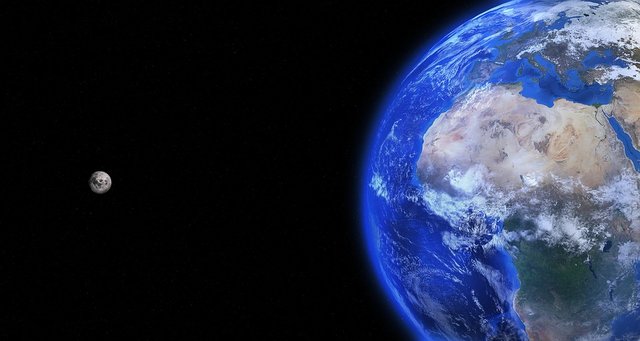
Image Source: pixabay.com
It's worth noting at this point that there are stars that are always observed to rise and set in the exact same areas of the horizon; in such cases the observer is moving on a spherical surface which is the very same reason why this happens. However Aristotle had much more to say and he did so. He assumed that the planet's radius had to be comparatively small based on the fact that the stars' observed location changes significantly as an observer moves on the Earth's surface. He also was the one to introduce time as a physical quantity included in calculations regarding motion and therefore merged the different but relevant concepts of time and space. Together with Plato (428 BC. - 348 BC.), they formulated the theory of time which described time as a consistent and irreversible straight line of successive events.
Aristarchus of Samos (310BC. - 230BC.) was one of the greatest theoretical astronomers of all times. He was the one who formulated the heliocentric theory which was a totally different approach regarding the nature of the Universe. He stated that the Earth rotates on its axis and revolves around the Sun simultaneously, notions that were totally opposite to the geocentric theory's propositions. Unfortunately Aristarchus' writings were lost and never found and as a result the geocentric theory prevailed and was broadly embraced during his time. However his beliefs and ideas were justified many centuries later, when Polish astronomer Nicolaus Copernicus (1473 - 1543) adopted Aristarchus' theory and supported it with measurements and observations. However he never gave credit to Aristarchus' ideas and beliefs which inspired him in his work and he is nowadays mistakenly considered as the father of the heliocentric theory. No cheetah or steemcleaners to get him back then!
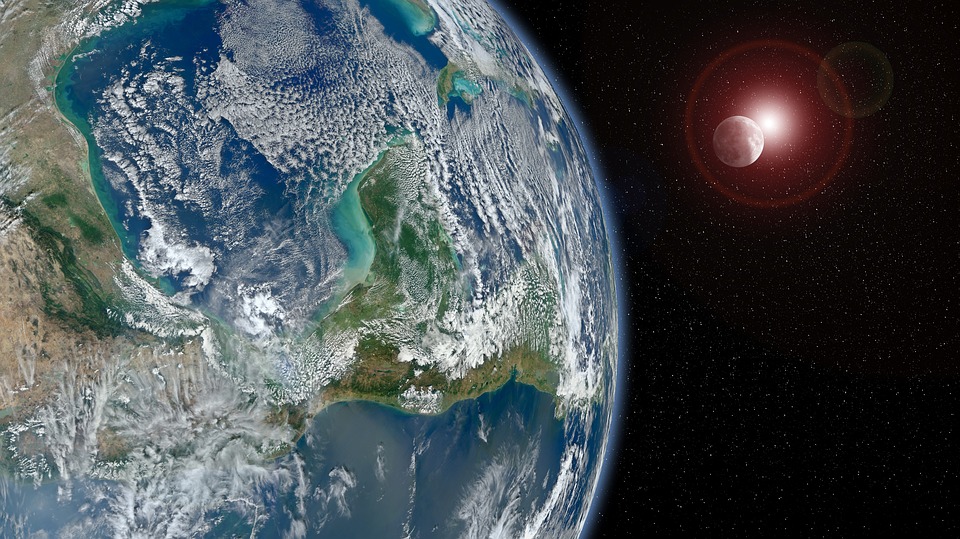
Image Source: pixabay.com
The Earth's motions
The planet moves together with the galaxy as a part of it throughout the Universe, a galaxy that also moves in relation to other neighbour and distant galaxies. The Earth also moves along with the rest of the celestial bodies in our solar system inside our own galaxy. The planet rotates at an angular velocity of 7.292e-05 rad/s (7.292 x 10^-5 rad/s) and revolves around our solar sytem's star at an orbital velocity of approximately 107306km/h. As mentioned in a previous introductory post, the Earth's tectonic plates' motions are also considered motions of our planet, however we will only be discussing the Earth's revolution around the Sun and the planet's different sorts of motions related to its rotary axis. This is not an introductory post so I will share advanced information regarding our planet's constant travel throughout the Universe.
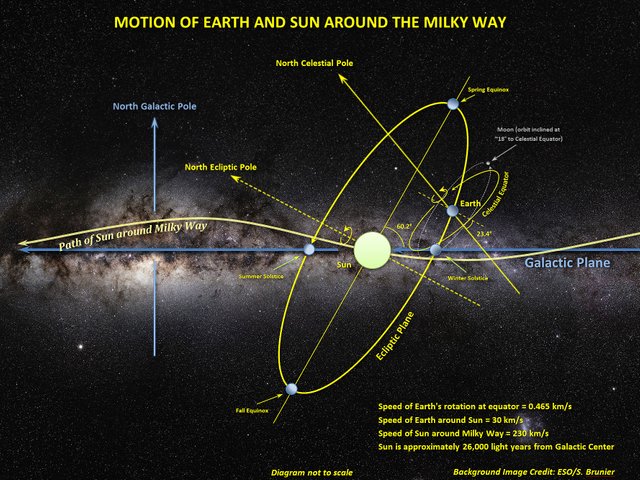
Image Source: commons.wikimedia.org
- The Earth's revolution around the Sun.
Our planet, just like most celestial bodies located in our solar system, revolves around the Sun. The Earth revolves around the Sun counter clockwise in an elliptical orbit and takes approximately 365 days to make a full revolution. This orbit is also referred to as ecliptic trajectory. The Earth's average speed on this ecliptic trajectory has a value of approximately 30km/sec. This specific sort of trajectory is almost circular but involves slight eccentricity, which basically means that the trajectory's actual shape is that of an ellipse. The magnitude of eccentricity determines the trajectory's abstention from a perfectly circular equivalent trajectory. Its value changes slightly every 100 000 years, ranging from 0.01 to 0.05 maximum. Nowadays the Earth's ecliptic trajectory's eccentricity has a value of 0.017, which basically means that the Earth revolves around our solar system's star in an almost circular orbit.
Once again, it is worth noting that the Earth's annual motion is most precisely described by the laws of celestial mechanics. In other words, it is much more practical to consider celestial bodies as material points and observe or study their motions accordingly. Assuming that the Earth is a material point of negligible volume in relation to the magnitude of dimensions in our solar system, its annual motion can be accurately described by utilizing the three laws of planetary motion formulated by Johannes Kepler (1571 - 1630). The first law of planetary motion basically states that all planets follow a trajectory that forms an ellipse around the Sun, in a way that the Sun is located at one of the two foci of the ellipse. The second law of planetary motion states that all planets move at a constant surface speed in their trajectories. In other words a planet's radial distance from the Sun covers equal areas during equal timeframes.
The third and most complicated law of planetary motion states that all planets' squared orbital periods are proportional to the cube of the small axis of each planet's orbit in particular (T^2/a^3). Due to the effects of the second law of planetary motion our planet moves a bit faster when closer to our solar system's star. A full revolution around the Sun takes approximately 365,242199 days, a time interval that is also known as the astral year. The point of the Earth's trajectory closest to the Sun is located at a distance of 147 090 000km from our solar sytem's star and is also known as perihelion. The Earth reaches that specific point in its orbit obviously once in a year and especially on the 4th of January. Six months later the Earth reaches the aphelion, which is a specific point of its trajectory that is located at a distance of roughly 152 000 000km from the Sun and is in fact the farthest away it ever gets.
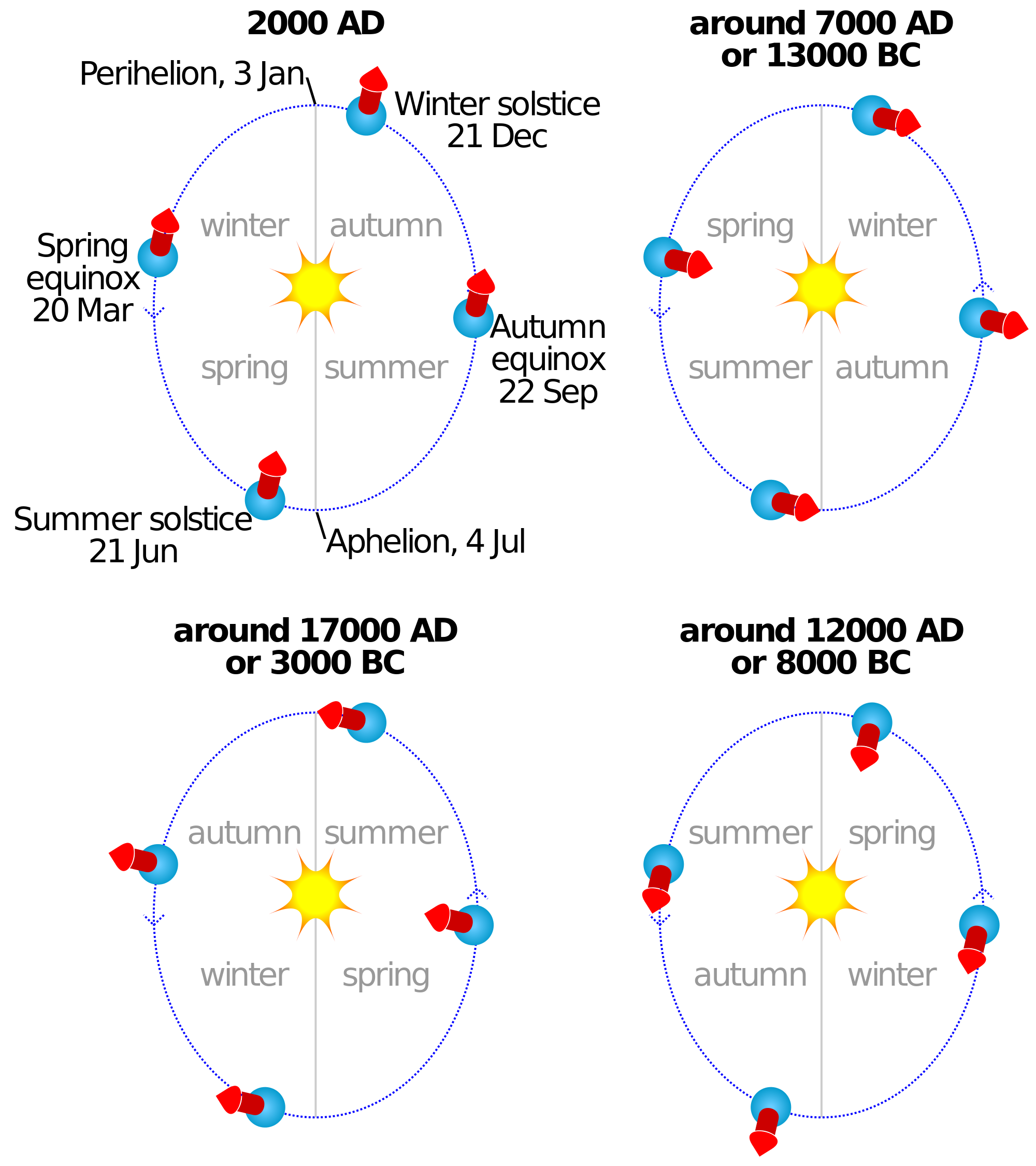
Image Source: commons.wikimedia.org
- Motions related to the Earth's rotary axis.
Our green planet rotates on its axis, taking approximately 0.997270 days to make a full rotation, a time interval that is also known as the astral day. Concerning the planet's daily rotation, the horizontal plane tangent to the Equator has a slope of 23,27 degrees in relation to the ecliptic trajectory's plane, which is also known as obliquity of the ecliptic. This slope is the very reason why there are four seasons on Earth and has been ranging from 22.1 to 24.5 degrees in the last 700 000 years. A rise in this slope's value causes higher contrast in terms of weather phenomena between summer and winter months, therefore as a result polar and tropical zones on the Earth's surface occupy larger areas. At times when this slope's value decreases, the sunrays are uniformly distributed between summer and winter months. Inevitably, larger differences in amounts of solar radiation between the Earth's poles and the Equator are observed.
The speed at which the Earth rotates on its axis is measured at 465m/sec on the Equator. This speed used to be a lot higher and therefore 2 billion years ago days consisted of 12 hours. The Earth's rotation on its axis practically affects the planet's shape, as a result the Earth is not perfectly spherical but instead slightly flattened on the Equator. This is due to the centrifugal force effect generated by the planet's spin. The gravitational pull of the Sun and the Moon in combination with the slope of 23.5 degrees of its rotary axis in relation to the vertical to the ecliptic trajectory's plane, are the main reasons why the Earth's daily rotary axis is actually revolving around the vertical to the ecliptic trajectory, forming a cone trace. This phenomenon is called transition of the axis. It is known that a time interval of 28 000 years is demanded for the Earth's rotary axis to shape a complete conical surface.
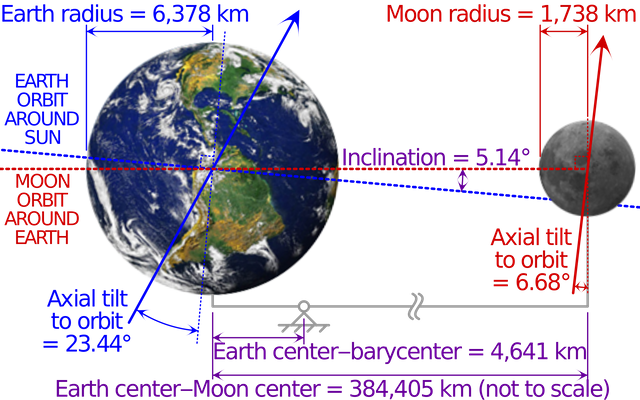
Image Source: commons.wikimedia.org
Due to the rotary axis' slope of 23.5 degrees the gravitational pull of the Sun and the Moon have different values on each pole of the Earth.The reason why the Earth's rotary axis' orientation isn't affected or changed at all by this difference in gravity voltage is the planet's gyroscopic behaviour. That basically means that the Earth's rotary axis is in circular motion at 90 degrees in relation to the direction of gravitational pull. It's safe to say the Earth is a whirligig. The Earth's rotary axis also demonstrates further variations in a periodic manner. The main cause of this motion is the moon's trajectory slope of 5 degrees in relation to the ecliptic trajectory. This phenomenon is usually observed as a corrugated movement in the basic trajectory of the cone of transition. This phenomenon along with the transposition of the Earth's rotary axis are motions that can be predicted and described using 3D models.
Last but never least, it has been observed that the Earth's rotary axis is actually being displaced by several meters in relation to the Earth's surface. This phenomenon is also known as motion of the pole and is basically comprised of two different periodic components: a time interval of 14 months and another one of 12 months. However, there are occasions of unpredictable variations in the trajectory of the pole's motion as the years go by. Such motions are always observed and the magnitude is measured by utilizing observations. Therefore, in 1899 the International Latitude Service (ILS) was established in order to administer all observations regarding the motion of the pole. However, nowadays the phenomenon is observed by the International Earth Rotation Service (IERS). The precise calculation and definition of the motion of the pole is rather important for Geodesy as it is directly related to the circumscription of the global reference system.
Hope you made it till the end! If you have any questions feel free to let me know in the comments below and I will do my best to provide prompt answers in a very detailed manner. I will keep doing my best to provide quality material enriched with a pinch of humour. You should follow me at your own risk, as these posts might start getting too nerdy! ;) I warned you!
IMAGE SOURCES:
REFERENCES:
University Textbooks & Lecture Notes:
Γεωδαισία ΙV / Geodesy IV - MILAS PARASKEVAS (National Technical University of Athens, School of Rural and Surveying Engineering course lectures)
Γεωδαισία V, Δορυφορική Γεωδαισία / Geodesy V, Satellite Geodesy - POURNARAS DIMITRIOS (National Technical University of Athens, School of Rural & Surveying Engineering course lectures)
Γεωμετρική Γεωδαισία, Εκδόσεις ΖΗΤΗ / Geometric Geodesy, ZHTH publications. - FWTIOU ARISTIDIS (National Technical University of Athens, School of Rural and Surveying Engineering university textbook)
Aνώτερη Γεωδαισία / Τοp Geodesics - BITHAS ANASTASIOS (National Technical University of Athens, School of Rural & Surveying Engineering course lectures)
Internet Links:
https://courses.lumenlearning.com/geophysical/chapter/earths-motions/
http://www.polaris.iastate.edu/NorthStar/Unit3/unit3_sub1.htm
https://spaceplace.nasa.gov/review/dr-marc-earth/earth-rotation.html
Thank you for your attention!
Hope you enjoyed this post and did learn a thing or two.
Follow me and stay tuned for more engineering blogs.
Highest Regards
@lordneroo


Being A SteemStem Member
i loved your geography of the earth .thank you
Thanks for dropping by ;)
Resteemed by @resteembot! Good Luck!
Curious? Read @resteembot's introduction post
Check out the great posts I already resteemed.
ResteemBot's Maker is Looking for Work
nice post
This post is Powered by @superbot all the way from Planet Super Earth.
Your post will Appear in the feed of 1200+ Followers :)
So don't waste any time ! Get More Followers and gain more Visibility With @superbot